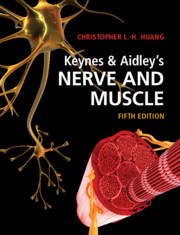Book contents
- Keynes & Aidley’s Nerve and Muscle
- Keynes & Aidley’s Nerve and Muscle
- Copyright page
- Dedication
- Contents
- Preface
- Acknowledgements
- Abbreviations used in the text
- 1 Structural Organisation of the Nervous System
- 2 Resting and Action Potentials
- 3 Background Ionic Homeostasis of Excitable Cells
- 4 Membrane Permeability Changes During Excitation
- 5 Voltage-Gated Ion Channels
- 6 Cable Theory and Saltatory Conduction
- 7 Neuromuscular Transmission
- 8 Synaptic Transmission in the Nervous System
- 9 The Mechanism of Contraction in Skeletal Muscle
- 10 The Activation of Skeletal Muscle
- 11 Excitation–Contraction Coupling in Skeletal Muscle
- 12 Contractile Function in Skeletal Muscle
- 13 Cardiac Muscle
- 14 Ion Channel Function and Cardiac Arrhythmogenesis
- 15 Smooth Muscle
- Further Reading
- References
- Index
8 - Synaptic Transmission in the Nervous System
Published online by Cambridge University Press: 07 November 2020
- Keynes & Aidley’s Nerve and Muscle
- Keynes & Aidley’s Nerve and Muscle
- Copyright page
- Dedication
- Contents
- Preface
- Acknowledgements
- Abbreviations used in the text
- 1 Structural Organisation of the Nervous System
- 2 Resting and Action Potentials
- 3 Background Ionic Homeostasis of Excitable Cells
- 4 Membrane Permeability Changes During Excitation
- 5 Voltage-Gated Ion Channels
- 6 Cable Theory and Saltatory Conduction
- 7 Neuromuscular Transmission
- 8 Synaptic Transmission in the Nervous System
- 9 The Mechanism of Contraction in Skeletal Muscle
- 10 The Activation of Skeletal Muscle
- 11 Excitation–Contraction Coupling in Skeletal Muscle
- 12 Contractile Function in Skeletal Muscle
- 13 Cardiac Muscle
- 14 Ion Channel Function and Cardiac Arrhythmogenesis
- 15 Smooth Muscle
- Further Reading
- References
- Index
Summary
Central nervous system function depends on synaptic transmission involving either chemical-transmitter-mediated or direct electrical coupling between neurones. Transmitter activation of excitatory and inhibitory synapses respectively produce postsynaptic membrane depolarisation and hyperpolarisation in turn increasing or decreasing likelihoods of action potential firing by the targetted neuron. Further variants of neuron-neuron interactions include inhibition at the level of presynaptic terminals and G-protein dependent slow synaptic potentials. Some central nervous system synapses additionally show longer-term potentiation or depression phenomena with repeated activity produced by intracellular signaling mechanisms; these may underly memory. Finally, direct electrical synaptic connections between cells can synchronise firing between neurones. Release of K+ and transmitter glutamate by central neurones during intense electrical activity potentially perturbs their extracellular environment. This is normally corrected by transport activity in their closely related glial cells. Malfunctions in this buffering function predisposes to cortical spreading depression phenomena clinically associated with migraine aura.
Keywords
- Type
- Chapter
- Information
- Keynes & Aidley's Nerve and Muscle , pp. 106 - 120Publisher: Cambridge University PressPrint publication year: 2020

